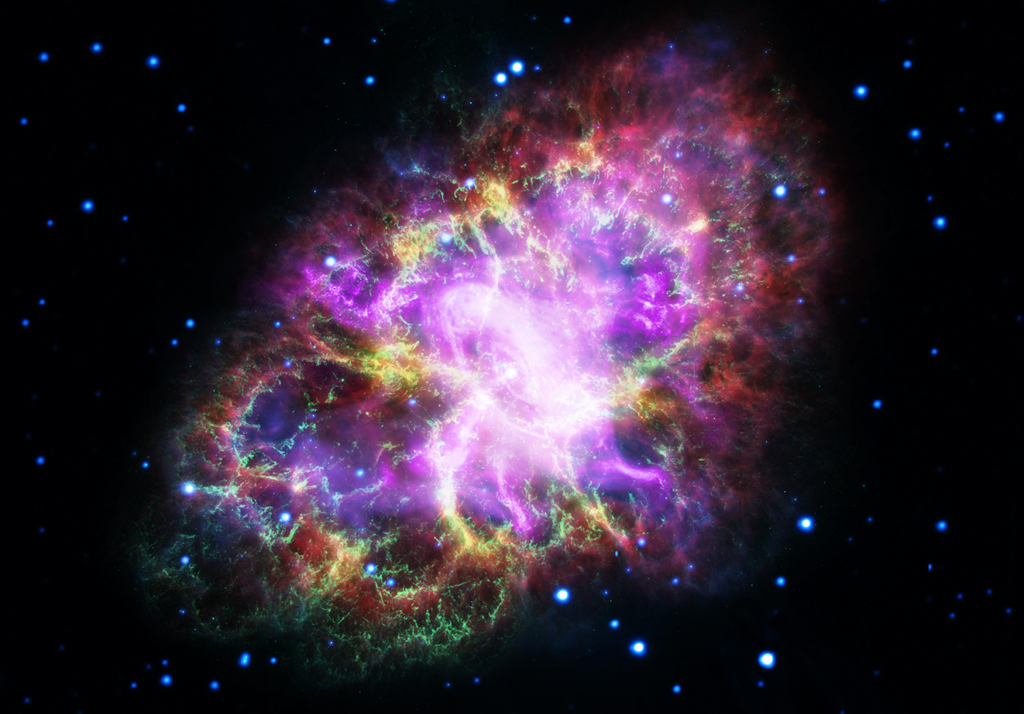04. March 2022
多波段 ê 毛蟹星雲

探索宇宙1!逐工會揀一幅無仝款 ê 影像抑是相片,𤆬你熟似咱這个迷人 ê 宇宙,閣有專業天文學者2為你3解說4。
- 原始文章:The Multiwavelength Crab
- 影像來源:NASA, ESA, G. Dubner (IAFE, CONICET-University of Buenos Aires) et al.;A. Loll et al.; T. Temim et al.; F. Seward et al.; VLA/NRAO/AUI/NSF; Chandra/CXC; Spitzer/JPL-Caltech; XMM-Newton/ESA; Hubble/STScI
- 台文翻譯:An-Li Tsai (NCU)
[漢羅] 多波段 ê 毛蟹星雲
毛蟹星雲 tī 彼个有名 ê Charles Messier 星表內底編做 M1,是星表內底頭一粒天體。 是講這个星表內底 ê 天體,攏毋是彗星。 實際上,咱這馬知影講,毛蟹星雲 其實 是一个 超新星殘骸。 伊是大質量恆星死亡爆炸了後,殘骸噴出去 ê 現象。 這个現象 tī 西元 1054 年 ê 時陣 去予人看著,一直到今。 這張大膽 ê 全新影像 是 毛蟹星雲 ê 21 世紀影像。 是 kā 規个 電磁頻譜 ê 觀測資料,用可見光影像來表示。 太空 ê 觀測資料是 ùi Chandra (X-光)、XMM-Newton (紫外光)、哈伯 (可見光)、kah Spitzer (紅外線) 望遠鏡來 ê,分別是 茄仔色、藍色、青色、kah 黃色。 地面 ê 觀測資料是 ùi 超大陣列電波望遠鏡 (VLA) 來 ê,是紅色 ê。 對現代天文學家來講,毛蟹星雲脈動星 實在是有夠特別 ê。 伊 ê 中心其實是一粒中子星,一秒鐘踅 30 輾。 相片中央彼粒光點 to̍h 是矣。 恆星核心崩塌 ê 殘骸,會當予毛蟹星雲 tī 規个電磁頻譜 發射電磁波,to̍h 親像是宇宙發電機仝款。 毛蟹星雲有 12 光年闊,離咱有 6500 光年遠。 咱會當 tī 金牛座 ê 方向揣著伊。
[POJ] To pho-tōaⁿ ê Mô͘-hē-seng-hûn
Mô͘-hē-seng-hûn tī hit-ê ū-miâ ê Charles Messier seng-pió lāi-té pian chò M1, sī seng-pió lāi-té thâu chi̍t-lia̍p thian-thé. Sī kóng chit-ê seng-pió lāi-té ê thian-thé, lóng m̄-sī hui-chhiⁿ. Si̍t-chè-siōng, lán chit-má chai-iáⁿ kóng, Mô͘-hē-seng-hûn kî-si̍t sī chi̍t-ê chhiau-sin-seng chân-hâi. I sī tōa-chit-liōng hêng-chhiⁿ sí-bông po̍k-chà liáu-āu, chân-hâi phùn--chhut-khì ê hiān-siōng. Chit-ê hiān-siōng tī se-goân 1054 nî ê sî-chūn khì hō͘ lâng khòaⁿ-tio̍h, it-ti̍t kàu-taⁿ. Chit-tiuⁿ tōa-táⁿ ê choân-sin iáⁿ-siōng sī Mô͘-hē-seng-hûn ê 21 sè-kí iáⁿ-siōng. Sī kā kui-ê tiān-chû pîn-phó͘ ê koan-chhek chu-liāu, iōng khó-kiàn-kng iáⁿ-siōng lâi piáu-sī. Thài-khong ê koan-chhek chu-liāu sī ùi Chandra (X-kng), XMM-Newton (chí-gōa-kng), Ha-peh (khó-kiàn-kng), kah Spitzer (âng-gōa-sòaⁿ) bōng-oán-kiàⁿ lâi ê, hun-pia̍t sī kiô-á-sek, nâ-sek, chhiⁿ-sek, kah n̂g-sek. Tē-bīn ê koan-chhek chu-liāu sī ùi Chhiau-tōa Tīn-lia̍t Tiān-pho Bōng-oán-kiàⁿ (VLA) lâi ê, sī âng-sek ê. Tùi hiān-tāi thian-bûn ha̍k-ka lâi-kóng, Mô͘-hē-seng-hûn si̍t-chāi sī ū-kàu te̍k-pia̍t ê. I ê tiong-sim kî-si̍t sī chi̍t-lia̍p tiōng-chú-chhiⁿ, chi̍t bió-cheng se̍h 30 liàn. Siòng-phìⁿ tiong-ng hit-lia̍p kng-tiám to̍h sī ah. Hêng-chhiⁿ he̍k-sim pang-lap ê chân-hâi, ē-tàng hō͘ Mô͘-hē-seng-hûn tī kui-ê tiān-chû pîn-phó͘ hoat-siā tiān-chû-pho, to̍h chhiⁿ-chhiūⁿ sī ú-tiū hoat-tiān-ki kāng-khoán . Mô͘-hē-seng-hûn ū 12 kng-nî khoah, lî lán ū 6500 kng-nî hn̄g. Lán ē-tàng tī Kim-gû-chō ê hong-hiòng chhōe-tio̍h i.
[KIP] To pho-tuānn ê Môo-hē-sing-hûn
Môo-hē-sing-hûn tī hit-ê ū-miâ ê Charles Messier sing-pió lāi-té pian tsò M, sī sing-pió lāi-té thâu tsi̍t-lia̍p thian-thé. Sī kóng tsit-ê sing-pió lāi-té ê thian-thé, lóng m̄-sī hui-tshinn. Si̍t-tsè-siōng, lán tsit-má tsai-iánn kóng, Môo-hē-sing-hûn kî-si̍t sī tsi̍t-ê tshiau-sin-sing tsân-hâi. I sī tuā-tsit-liōng hîng-tshinn sí-bông po̍k-tsà liáu-āu, tsân-hâi phùn--tshut-khì ê hiān-siōng. Tsit-ê hiān-siōng tī se-guân 1054 nî ê sî-tsūn khì hōo lâng khuànn-tio̍h, it-ti̍t kàu-tann. Tsit-tiunn tuā-tánn ê tsuân-sin iánn-siōng sī Môo-hē-sing-hûn ê 21 sè-kí iánn-siōng. Sī kā kui-ê tiān-tsû pîn-phóo ê kuan-tshik tsu-liāu, iōng khó-kiàn-kng iánn-siōng lâi piáu-sī. Thài-khong ê kuan-tshik tsu-liāu sī uì Chandra (X-kng), XMM-Newton (tsí-guā-kng), Ha-peh (khó-kiàn-kng), kah Spitzer (âng-guā-suànn) bōng-uán-kiànn lâi ê, hun-pia̍t sī kiô-á-sik, nâ-sik, tshinn-sik, kah n̂g-sik. Tē-bīn ê kuan-tshik tsu-liāu sī uì Tshiau-tuā Tīn-lia̍t Tiān-pho Bōng-uán-kiànn (VLA) lâi ê, sī âng-sik ê. Tuì hiān-tāi thian-bûn ha̍k-ka lâi-kóng, Môo-hē-sing-hûn si̍t-tsāi sī ū-kàu ti̍k-pia̍t ê. I ê tiong-sim kî-si̍t sī tsi̍t-lia̍p tiōng-tsú-tshinn, tsi̍t bió-tsing se̍h 30 liàn. Siòng-phìnn tiong-ng hit-lia̍p kng-tiám to̍h sī ah. Hîng-tshinn hi̍k-sim pang-lap ê tsân-hâi, ē-tàng hōo Môo-hē-sing-hûn tī kui-ê tiān-tsû pîn-phóo huat-siā tiān-tsû-pho, to̍h tshinn-tshiūnn sī ú-tiū huat-tiān-ki kāng-khuán . Môo-hē-sing-hûn ū 12 kng-nî khuah, lî lán ū 6500 kng-nî hn̄g. Lán ē-tàng tī Kim-gû-tsō ê hong-hiòng tshuē-tio̍h i.
[English] The Multiwavelength Crab
The Crab Nebula is cataloged as M1, the first object on Charles Messier's famous list of things which are not comets. In fact, the Crab is now known to be a supernova remnant, expanding debris from massive star's death explosion, witnessed on planet Earth in 1054 AD. This brave new image offers a 21st century view of the Crab Nebula by presenting image data from across the electromagnetic spectrum as wavelengths of visible light. From space, Chandra (X-ray) XMM-Newton (ultraviolet), Hubble (visible), and Spitzer (infrared), data are in purple, blue, green, and yellow hues. From the ground, Very Large Array radio wavelength data is in shown in red. One of the most exotic objects known to modern astronomers, the Crab Pulsar, a neutron star spinning 30 times a second, is the bright spot near picture center. Like a cosmic dynamo, this collapsed remnant of the stellar core powers the Crab's emission across the electromagnetic spectrum. Spanning about 12 light-years, the Crab Nebula is 6,500 light-years away in the constellation Taurus.
詞彙學習
| 漢羅 | POJ | KIP | 華語 | English |
|---|---|---|---|---|
| 毛蟹星雲 | Mô͘-hē-seng-hûn | Môo-hē-sing-hûn | 蟹狀星雲 | the Crab Nebula |
| 星表 | seng-pió | sing-pió | 星表 | cataloge |
| M1 | M it | M it | M1 | M1 |
| 超新星殘骸 | chhiau-sin-seng chân-hâi | tshiau-sin-sing tsân-hâi | 超新星殘骸 | supernova remnant |
| 大質量恆星 | tōa-chit-liōng hêng-chhiⁿ | tuā-tsit-liōng hîng-tshinn | 大質量恆星 | massive star |
| 西元 1054 年 | se-goân it-khòng-ngó͘-sù nî | se-guân it-khòng-ngóo-sù nî | 西元 1054 年 | 1054 AD |
| 電磁頻譜 | tiān-chû pîn-phó͘ | tiān-tsû pîn-phóo | 電磁頻譜 | electromagnetic spectrum |
| 超大陣列電波望遠鏡 | Chhiau-tōa Tîn-lia̍t Tiān-pho Bōng-oán-kiàⁿ | Tshiau-tuā Tîn-lia̍t Tiān-pho Bōng-uán-kiànn | 超大陣列電波望遠鏡 | Very Large Array (VLA) |
| 恆星核心 | hêng-chhiⁿ he̍k-sim | hîng-tshinn hi̍k-sim | 恆星核心 | stellar core |
| 崩塌 | pang-lap | pang-lap | 崩塌 | collapse |
| 毛蟹星雲脈動星 | Mo͘-hē-seng-hûn Be̍k-tōng-chhiⁿ | Moo-hē-sing-hûn Bi̍k-tōng-tshinn | 毛蟹星雲脈衝星 | the Crab Pulsar |
| 中子星 | tiōng-chú-chhiⁿ | tiōng-tsú-tshinn | 中子星 | neutron star |
| 電磁波 | tiān-chû-pho | tiān-tsû-pho | 電磁波 | electromagnetic wave |
| 金牛座 | Kim-gû-chō | Kim-gû-tsō | 金牛座 | Taurus |